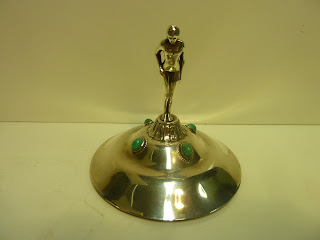I found a picture portrait of a young lady while clearing out the stores of a man who, when asked, described himself as a hoarder, collector.
“With the emphasis on the hoarder” I jokingly replied.
He laughed.
Why I volunteer for these jobs I will never know.
Up to my knees in boxes, wading in junk. I love it.
Yes there is one side of the vocation I have chosen. The public talks and valuations of great sculpture and the appraisals of valuable works of art.
Then there is reality. In a dark dank space, sorting through other peoples discarded possessions. Wiping away the dirt and mould hoping to reveal hidden treasure.
Its like being Indiana Jones, of Junk.
Yes, if it was that easy we'd all be doing it.
Sifting and syphoning. With a torch. Falling over stuff. Upside down, feet sticking out of tea chests.
Oh and the old Singer sewing machine that unexpectantly fell apart and landed corner side, on my foot...and broke my toe.
That hurt.
If it was not for the adrenelin of being drunk on junk, I would have cried as I watched the black and blue toe balloon grow ever larger.
Man, that was painfull. The things I do for my job.
I took this little picture of a pretty lady home and placed it on the top of a mirror which I had no space to hang, so it was tilted on the wall.
My brushpan hit the mirror and off she toppled to the floor breaking apart in front of my eyes.
Now, once I take an abandonded and forgotten item into, my care, I get upset if I break it. I want to give things a new lease of life, a new home. There it was on the floor, ruined.
I brushed the scattered pieces on to the shovel and to my surprise there were some things that had fallen out from between the picture and the frame.
Leaning in, I shuffled them around. To find, a carefully and lovingly placed lock of hair, in the corner of an envelope.
And a newspaper cutting. With a poem.
I sat down and read it out loud.
When clouds have vanished and skies are blue,
I'll come back, sweetheart, to you,
Back to the best pal I ever knew,
Your smiles and your love so true:
Back through the gateway of golden days,
There my dream love always stays,
When clouds have vanished and skies are blue,
I'll come back to you.
I looked into the gaze of the pretty lady wishing I knew who she was.
She had touched my heart as I shed a tear.
I repaired the little momento of anothers past and placed it in a better spot where it won't ever get harmed.
And now, this anonymous lady,
Is a part of my life too.
She stares back at me, as if to thank me:
The pretty girl I never knew,
Her, with those smiles and love so true.
©Wayne Colquhoun








































